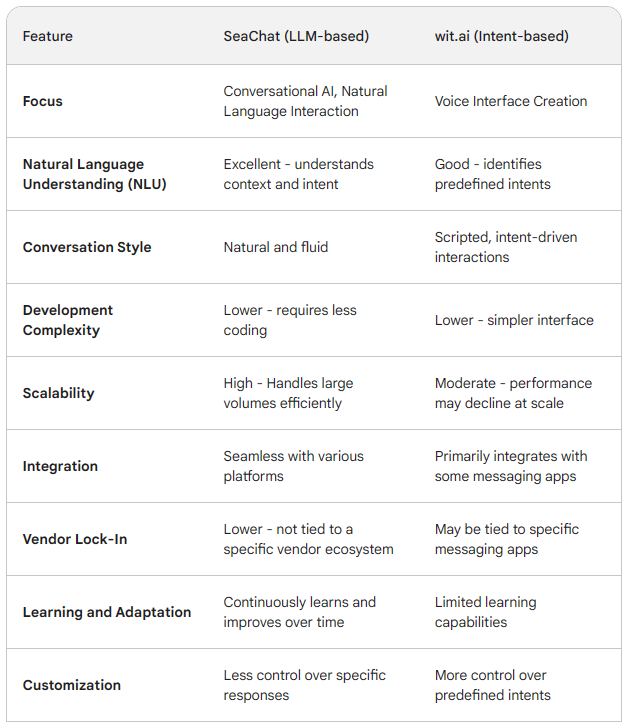The world of chatbots is evolving at breakneck speed. While Meta/Facebook’s wit.ai has served as a stepping stone for building voice-powered applications, a new wave of technology is taking center stage: Large Language Models (LLMs). SeaChat, a platform built on LLM technology, offers a groundbreaking approach to Conversational AI, leaving intent-based engines like wit.ai behind. Is it time to consider an upgrade for your chatbot?
wit.ai: A Simple Entry Point, But Limited in Scope
wit.ai has established itself as a user-friendly platform for building basic voice interfaces. Its focus on intent recognition allows developers to get started quickly, particularly for simple applications.
Here are some of wit.ai’s strengths:
- Accessibility: The straightforward interface simplifies the creation of basic voice interfaces, making it a good option for beginners or small-scale projects.
- Focus on Intent Recognition: Extracting user intent from spoken language is core to wit.ai’s functionality. This can be helpful for tasks requiring simple user input.
- Free Tier: wit.ai offers a free tier, making it an attractive option for developers on a budget or experimenting with voice applications.
However, as your chatbot project grows in complexity, wit.ai’s limitations become apparent:
- Limited Natural Language Understanding (NLU): Understanding the nuances of human language and context is beyond wit.ai’s capabilities. This leads to a stilted and unnatural conversation flow.
- Scripted Interactions: wit.ai primarily relies on predefined intents, forcing conversations down a rigid path. This fails to capture the dynamic nature of spoken language.
- Scalability Concerns: Performance may decline when handling high volumes of user interactions, hindering growth potential.
SeaChat: Charting a Course for the Future of Conversational AI
SeaChat, powered by LLM technology, offers a dramatic leap forward in Conversational AI, leaving wit.ai’s limitations in the dust:
- Advanced Natural Language Understanding (NLU): SeaChat excels at comprehending the subtleties of human language, enabling it to hold natural and context-driven conversations.
- Conversational Learning: SeaChat continuously learns and adapts based on user interactions, constantly improving its ability to handle complex queries.
- Seamless User Experience: By understanding context and intent, SeaChat fosters a more natural flow of conversation, mimicking human interaction.
Here’s why SeaChat can elevate your Conversational AI:
- Enhanced User Engagement: Users crave chatbots that feel like talking to a person. SeaChat’s advanced NLU capabilities, powered by LLMs, deliver on this promise, creating a more engaging and satisfying user experience.
- Reduced Development Time: Building chatbots with SeaChat often requires less coding compared to intent-based engines like wit.ai. This frees up development resources for building robust functionalities.
- Scalability for Growth: SeaChat effortlessly handles large volumes of user interactions, ensuring smooth performance even during peak times. This makes it ideal for businesses with high growth potential.
A Feature Comparison: wit.ai vs. SeaChat
Let’s delve deeper with a table to see how wit.ai and SeaChat stack up:

SeaChat vs. Meta (Facebook) wit.ai
Study has shown the difference of intent/entity based NLU vs. LLM-based NLU is in the millions: in terms of training examples, it’s 630,000 examples versus a mere 32. This dramatic reduction in training data requirements translates to significant cost savings for businesses adopting GenAI/LLM-based NLU.
Setting Sail for a More Engaging Chat Experience
The future of Conversational AI lies in natural, engaging interactions. While wit.ai has served its purpose as a basic voice interface builder, SeaChat offers a revolutionary approach powered by LLMs. Consider upgrading your chatbot to SeaChat for a more dynamic and human-like experience.


 Subscribe
Subscribe